I opened up the site to my blog today (on a work and 4th of July holiday break), and much like the wines that sit near me every day, it has gathered dust. Like, lots of it. (But the benefit is that my wine has also grown in numbers, so there’s that…)
A friend recently asked me, upon looking at my rack (wine, that is), “You’re apartment is so clean, yet there is dust on your wine? I think it’s because you want it to look aged. Yes?”
It was a great question, actually, and brought me to quick attention—why haven’t I been drinking my collection? Am I a poser? Am I on the wagon? (Um, hardly). Without venturing into TMI territory, I realized might need to actually start to dust off that wine, this blog, and maybe a little bit of myself.
And as I searched for the elusive WordPress password, I heard Josh Ritter sing “Homecoming” and that felt like the right sentiment for today: ”I first tasted the universe on a night like this/A box of wine, and I’ll abide…”
So here I am. Abiding my drinking hobby from one of the two boxes of wines in my fridge. (Or maybe both. But I apparently have to tell you, since I’m going to mention both wines. And since I’m hanging solo during a hot, holiday weekend, am not yet prepared to dust off the other bottles).
Why a box? Many reasons. Convenience. It says fresher for longer (read: maybe three weeks vs. three days of opening a bottle). Boxed wines are meant to be consumed soon after “bagging,” –like within a year— because the bags allow oxygen to pass through which will ultimately make them less fresh over time. Please don’t buy box wines with the purpose of stockpiling—I won’t be coming to dinner if you are serving a vintage 2000 from cardboard. I may even defriend you on Facebook, but I digress.
The Wines:

The Bota Box Chardonnay is a little lackluster for the varietal in that it showcases neither oak nor mineral…but just is, and sometimes, that’s okay. It’s cold, tasty in a non-descript, unoffensive way with hints of the tropical fruits it boasts and goes with anything. This is a fine wine, and for $18/box (which is about 3 liters or 4 bottles of wine), you’d be fine serving to friends, the jersey shore crowd that’s currently packed around my apartment-complex pool sporting cans of beer, or yourself after a bikeride, run or long day on the sofa.
 (The pool/party/people in the picture are why: 1. I don’t mind drinking in my apartment 2. Have box wine at the avail).
(The pool/party/people in the picture are why: 1. I don’t mind drinking in my apartment 2. Have box wine at the avail).
The Alverdi Pinot Grigio is a deviation from my normal boxed PG, but it still holds the flavor profile of the Pinot Grigio grape quite nicely. High acidity, crisp notes of green fruit and a hint of flowers, I’d say this is a win—in a bottle or a box. The added benefit is that this box runs around $22 for 3 liters.
If buying only one boxed wine to start out, I’d lean toward a Pinot Grigio (even if you can’t find this brand). I find it’s a little harder to mess up a more straight-forward varietal like a Pinot Grigio than the Chardonnay—where these wines can display high elegance and $$$ if you happen on the right one. (Translation: You are probably not going to find the best representation of Burgandy in a box. Just a guess on my part, but there’s more tasting to be done!!)
Both have won awards from Wine Enthusiast and for good reason—these are completely drinkable, affordable and won’t embarrass the posse or yourself if you pull this out to serve…or hide away from the crowds. (Wines purchased at the Wine & Spirits store).
What/Why I’m drinking these: These wines pair with the HEAT that is 4th of July weekend in Philadelphia; exhausting bike rides and runs around the city, and a general disdain of shopping for cold bottles from the Wine & Spirits shop that has grown to great distances during “Construction Season” in the city. PLUS, I’m hanging solo (completely +0) for the weekend, and the boxed wine allows me flexibility of not finishing the 6 or so bottles cumulatively within. My goal is to still make the workout in the a.m. (And I’ve succeeded the past four days during this long weekend!)
(According the above description, it also pairs nicely with plans to go into the U.S. Marshal’s Witness Protection Program, but if you hit that stage of the game, spring for a nice bottle or two. See: Burgandy, White. You don’t have storage needs.)
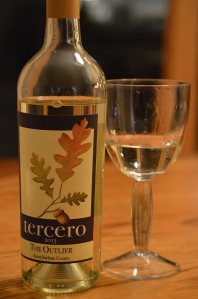



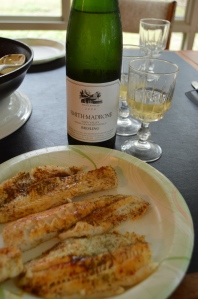
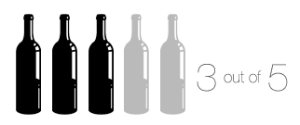



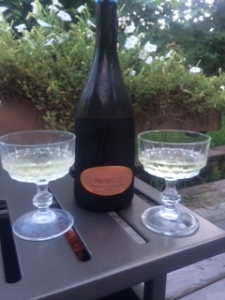

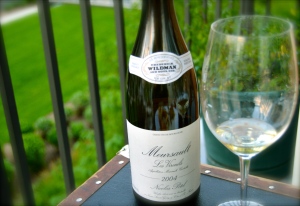


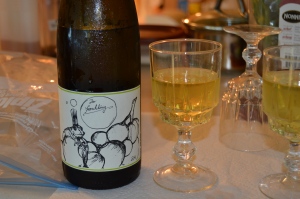 result: A delightful, elegant and surprisingly impactful dry Riesling that tasted of still, vintage champagne. While no yeast touched the process, this wine opened with zesty, fruity and flowery notes of golden apple, gooseberry, and white flowers and opened into notes of yeast and minerality. Like a fairy tale, the high acid and long finish was like a finely filtered ray of sunlight that one could hold in the palm, and palette, to remember the day in one’s senses. Highly recommend.
result: A delightful, elegant and surprisingly impactful dry Riesling that tasted of still, vintage champagne. While no yeast touched the process, this wine opened with zesty, fruity and flowery notes of golden apple, gooseberry, and white flowers and opened into notes of yeast and minerality. Like a fairy tale, the high acid and long finish was like a finely filtered ray of sunlight that one could hold in the palm, and palette, to remember the day in one’s senses. Highly recommend.


